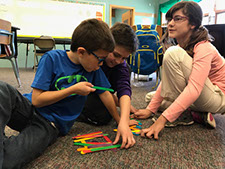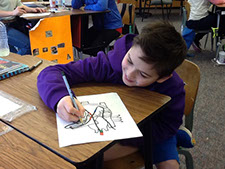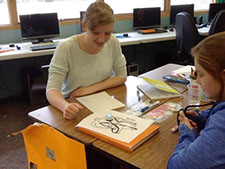discover
B
Head teacher, Hillcrest Seventh-day adventist school
‘Our Creator’s Space’ —
Pilot Program
“
ut, Mrs. Frishman, I don’t want science class to end!” That is something every teacher wants to hear. I was able to hear comments similar to this for two weeks thanks to an incredible program we piloted. We are, Hillcrest SDA School, a two-teacher school located in Jamestown, North Dakota and we had the opportunity to participate in “Our Creator’s Space” through Southern Adventist University.
In order to engage students, Ms. Gutknecht, the lower grades teacher, and myself have attempted to utilize the STEAM (science, technology, engineering, art, and math) approach in our classrooms. Unfortunately, in small schools limited resources make it difficult to provide the latest technology and methods. That is why we were excited to pilot these lessons. “Our Creator’s Space” was able to fill the void created by our lack of resources.
“‘Our Creator’s Space’ is meant to bring STEAM activities with a makerspace approach to small school classrooms, but with a focus on learning more about who Our Creator is through the lessons, learning experiences, and discussions,” per Pegi Flynt, developer of “Our Creator’s Space”. We piloted two lessons, the circulatory system and forces of motion. Both of the classrooms participated in these lessons, but the activities were tailored to be appropriate for each grade level.



Summer 2017
Through the program we were able to obtain Google Cardboard Virtual Reality headsets and Ozobots, along with supplies for each of the hands-on activities planned. During our study of the circulatory system, we were able to utilize multiple methods to engage learning. For example, our students experienced an inside view of the heart, veins, and arteries using Google Cardboard. Students were able to follow the path that blood travels through the body. The experience included viewing the effects of plaque on the vessels.
The focus for the second week was forces of motion. We continued our use of Google Cardboard where students viewed a rollercoaster as if they were riding it. They used this experience to help them design their own rollercoasters for their Ozobot to travel. Ozobots are small robots that make movements based on color codes. Students had to make the correct color combinations on their tracks for their Ozobot to traverse. This would demonstrate the potential and kinetic energy of their rollercoaster. This was just one of many fun projects that allowed the students to view a concept that is sometimes hard to grasp.
The advantage of STEAM versus traditional lecture methods is that critical thinking, hands-on experiences, and creativity are at the core. This approach allows the students to connect their learning to an experience and makes concepts more tangible for them. Students who feel they have more ownership of their learning retain information better and are more willing to participate.
Our school was blessed to be allowed the opportunity to take part in this pilot program.
We now have the ability to use these resources for all subjects throughout the year. We have already used the Google Cardboard headsets to take a virtual field trip to Sutter’s Mill in California where the Gold Rush began. Maybe we will use our Ozobots next to map Paul’s missionary journeys. The possibilities are endless. We are excited for the future and how we can involve the resources gained from “Our Creator’s Space!”